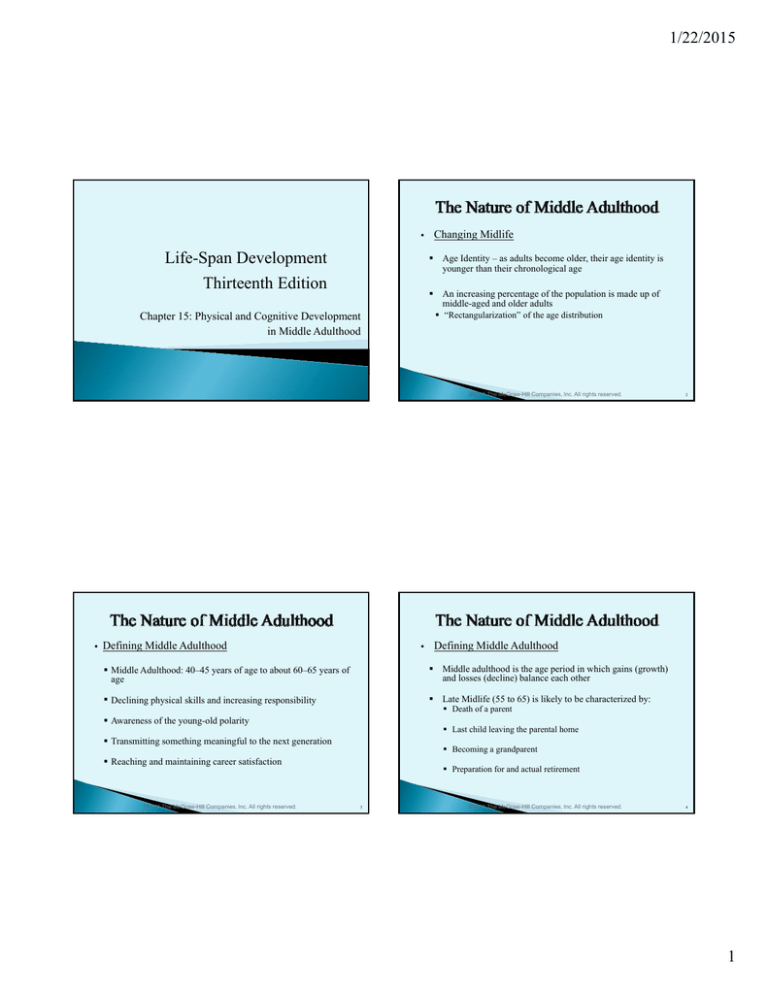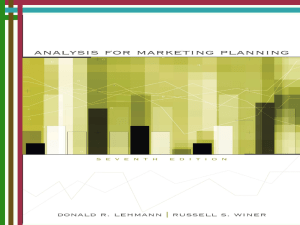
1/22/2015
Life-Span Development
Thirteenth Edition
Changing Midlife
Age Identity – as adults become older, their age identity is
younger than their chronological age
An increasing
i
i percentage off the
h population
l i is
i made
d up off
middle-aged and older adults
“Rectangularization” of the age distribution
Chapter 15: Physical and Cognitive Development
in Middle Adulthood
©2011 The McGraw-Hill Companies, Inc. All rights reserved.
Defining Middle Adulthood
Defining Middle Adulthood
Middle Adulthood: 40–45 years of age to about 60–65 years of
age
Middle adulthood is the age period in which gains (growth)
and losses (decline) balance each other
Declining physical skills and increasing responsibility
Late Midlife ((55 to 65)) is likely
y to be characterized by:
y
Death of a parent
Awareness of the young-old polarity
Last child leaving the parental home
Transmitting something meaningful to the next generation
Becoming a grandparent
Reaching and maintaining career satisfaction
©2011 The McGraw-Hill Companies, Inc. All rights reserved.
2
Preparation for and actual retirement
3
©2011 The McGraw-Hill Companies, Inc. All rights reserved.
4
1
1/22/2015
Physical Changes:
Visible Signs
Physical Changes:
Height and Weight
Wrinkling and sagging of skin
Individuals lose height and gain weight
Appearance of aging spots
Both obesity and severe weight loss can pose health risks
Hair becomes thinner and grayer
Nails become thicker and more brittle
Yellowing of teeth
©2011 The McGraw-Hill Companies, Inc. All rights reserved.
©2011 The McGraw-Hill Companies, Inc. All rights reserved.
5
Physical Changes
6
Physical Changes
Vision and Hearing
Strength, Joints, and Bones
Sarcopenia: age-related loss of muscle mass and strength
Accommodation of the eye (ability to focus and maintain an
image) experiences sharp declines between 40–59 years
efficient often leading
Cushions for bone movement become less efficient,
to joint stiffness and more difficulty in movement
Difficulty viewing close objects
Reduced blood supply decreases visual field
Progressive bone loss
Hearing can start to decline by the age of 40
High-pitched sounds are typically lost first
©2011 The McGraw-Hill Companies, Inc. All rights reserved.
7
©2011 The McGraw-Hill Companies, Inc. All rights reserved.
8
2
1/22/2015
Physical Changes
Cardiovascular System
Physical Changes
Lungs
High blood pressure, high cholesterol, and cardiovascular disease
Lung tissue becomes less elastic at about age 55, decreasing the
lung’s
g capacity
p y
Metabolic Syndrome: a condition characterized by hypertension,
obesity, and insulin resistance
Sleep
Wakeful periods become more frequent in the 40’s
Exercise, weight control, and a diet rich in fruits, vegetables, and
whole grains can often help
©2011 The McGraw-Hill Companies, Inc. All rights reserved.
Less deep sleep (stage 4)
©2011 The McGraw-Hill Companies, Inc. All rights reserved.
9
10
Physical Changes
Health and Disease
Chronic Disorders: a slow inset and a long duration
Rare in early adulthood but increase in middle age
Stress and Disease
The Immune System and Stress
Stress and the Cardiovascular System
Culture and Health
©2011 The McGraw-Hill Companies, Inc. All rights reserved.
11
©2011 The McGraw-Hill Companies, Inc. All rights reserved.
12
3
1/22/2015
Mortality Rates
Chronic diseases are the main cause of death during middle
adulthood
Sexuality
Climacteric: the midlife transition in which fertility declines
Heart disease
M
Menopause: ti
time in
i middle
iddl age (late
(l t 40s
40 to
t early
l 50s)
50 ) when
h a
woman’s menstrual periods completely cease
Cancer
Perimenopause: transitional period; often takes up to 10 years
In 2005, cancer was the leading cause of death in 45–64year-olds followed by cardiovascular disease
©2011 The McGraw-Hill Companies, Inc. All rights reserved.
Heredity and experience influence the onset of menopause
©2011 The McGraw-Hill Companies, Inc. All rights reserved.
13
Sexuality
Sexuality
Menopause
14
Hormonal Changes in Middle-Aged Men
Modest decline in sexual hormone level and activity
Erectile Dysfunction: inability to achieve and maintain an erection
May stem from physiological problems
Hot flashes, nausea, fatigue, and rapid heartbeat
Not the
h negative
i experience
i
it
i once was
Sexual Attitudes and Behavior
Sexual activity occurs less frequently than in early adulthood
Middle-aged men are more interested in sex than middle-aged
women
Hormone Replacement Therapy (HRT) is controversial; long
term use should be seriously reevaluated
Living with a spouse or partner makes all the difference in terms of
engaging in sexual activity
©2011 The McGraw-Hill Companies, Inc. All rights reserved.
15
©2011 The McGraw-Hill Companies, Inc. All rights reserved.
16
4
1/22/2015
Sexuality
Intelligence
Crystallized Intelligence: an individual’s accumulated
information and verbal skills
Continues to increase in middle adulthood
Fluid Intelligence: the ability to reason abstractly
May begin to decline in middle adulthood
©2011 The McGraw-Hill Companies, Inc. All rights reserved.
©2011 The McGraw-Hill Companies, Inc. All rights reserved.
17
Intelligence
18
Intelligence
The Seattle Longitudinal Study: study of intellectual abilities
in adulthood years (Schaie)
Peak performance on vocabulary, verbal ability, inductive
reasoning, and spatial orientation was attained in middle age
Decline in numerical ability and perceptual speed
©2011 The McGraw-Hill Companies, Inc. All rights reserved.
19
©2011 The McGraw-Hill Companies, Inc. All rights reserved.
20
5
1/22/2015
Intelligence
Information Processing
Speed of Information Processing
Insert Figure 15.6
Perceptual speed begins declining in early adulthood and continues
to decline in middle adulthood
Expertise
Expertise often shows up more in middle adulthood than in early
adulthood
©2011 The McGraw-Hill Companies, Inc. All rights reserved.
Memory
©2011 The McGraw-Hill Companies, Inc. All rights reserved.
21
Information Processing
Rely on accumulated experience
Process information automatically and analyze it more efficiently
Have better strategies and shortcuts to solving problems
Are more creative and flexible in solving problems
22
Work in Midlife
The role of work is central during middle age
Verbal memory declines during middle adulthood according to
most researchers
p aged
g 40-59 yyears of age
g are
In the U.S., about 80% of ppeople
employed
Linked to changes in working memory and ineffective memory
strategies
A time of evaluation, assessment, and reflection about work
Practical Problem Solving
Remains stable in early and middle adulthood, then declines in
late adulthood
©2011 The McGraw-Hill Companies, Inc. All rights reserved.
23
©2011 The McGraw-Hill Companies, Inc. All rights reserved.
24
6
1/22/2015
Work in Midlife
Current Challenges and Changes
Leisure
Pleasant times after work when individuals are free to
pursue activities and interests of their own choosing
Currently, middle-aged workers face several challenges in the 21st
century
Globalization and exporting
p
g of jjobs
Compared with those who never took vacations, men who
went on annual vacations were 21% less likely to die over
the 9 years studied, and 32% less likely to die of coronary
disease
Rapid developments in information technologies
Downsizing organizations
Early retirement
Pensions and health care
©2011 The McGraw-Hill Companies, Inc. All rights reserved.
25
©2011 The McGraw-Hill Companies, Inc. All rights reserved.
26
Religion and Adult
Lives
Religion and Adult Lives
More than 70% of middle-aged adults are religious and
consider spirituality a major part of their lives
Increase in spirituality tends to occur between late middle
adulthood and late adulthood
Women have consistently shown a stronger interest in
religion than males
©2011 The McGraw-Hill Companies, Inc. All rights reserved.
27
©2011 The McGraw-Hill Companies, Inc. All rights reserved.
28
7
1/22/2015
Religion and Health
Meaning in Life
Baumeister and Vohs (2002) argue that the quest for the
meaning of life may be understood in terms of four main
needs:
Religion is positively linked to health
Frankl (1984) identified the three most distinct human qualities
as:
Need
N d ffor purpose
Spirituality
Need for values
Freedom
Need for a sense of efficacy
Responsibility
Need for self-worth
©2011 The McGraw-Hill Companies, Inc. All rights reserved.
29
©2011 The McGraw-Hill Companies, Inc. All rights reserved.
30
8





